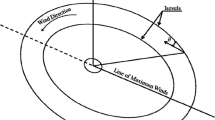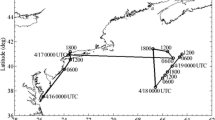Abstract
Nearshore sea levels in the East China Sea (ECS) and the South China Sea (SCS) during tropical cyclones—Typhoon 8007 (Joe, 1980) and Typhoon 7209 (Betty, 1972) were simulated. The tide-surge interactions in the two regions are remarkable and locally produced. The corresponding nonlinear effects were derived from the different nonlienar terms. The contribution of the quadratic friction term is the most important, the shallow term comes second the convective term is the least; the phases of the interactions generated by the various nonlinear terms are asynchronous. Both the quadratic friction and the convective term can stimulate and aggravate the surge structure with more peaks. The bottom friction features have crucial influences on tides and surges, and the interaction is sensitive to the changes of tide and surge.
Similar content being viewed by others
References
Banks, J. E., 1974. A mathematical model of a river-shallow sea system used to investigate tide, surge and their interaction in the Thames-Southern North Sea region.Phil. Trans. R. Soc. A 275: 567–609.
Fang Guohong, 1980. The nonlinear effects of the tidal friction (I).Oceanol. et Limnol. Sinica 11(2): 98–107. (in Chinese with English abstract)
Fang Guobong, 1981. The nonlinear effects of the tidal friction (II).Oceanol. et Limnol. Sinica 12(3): 195–209 (in Chinese with English abstract)
Fang Guohong, 1986. Tide and tidal current charts for the marginal seas adjacent toChina.Chin. J. Oceanol. Limnol. 4(1): 1–16.
Heaps, N. S., 1983. Storm surges, 1967–1982.Geophys J. R. Astro. Soc. 74: 331–376.
Hse, S. A., 1986. A mechanism for the increase of wind stress(drag) coefficient with wind speed over water surface.J. Phys. Ocean. 16: 144–150.
Jelesnianski, C. P., 1967. Numerical computations of storm surges with bottom stress.Mon. Weath. Rev. 95: 740–756.
Jelesnianski, C. P., 1970. Bottom stress time history in linearized equations of motion for storm surges.Mon. Weath. Rev. 98: 462–478.
Kielmann, J. and Kowalik, Z., 1980. A bottom stress formulation for storm surge problems.Oceanol. Acta 3: 51–58.
Leendertse, J. J., 1967. Aspects of a Computational Model for Long-period Water-wave Propagation. Rep. RM-5294-PR, Rand Corporation, Santa Monica, Ca 165 pp.
Murty, T. S., 1984. Storm Surge meteorological Tides, Friesen Printers Ltd., Monitoba, Canada, 897 pp.
Proudman, J., 1955a. The propagation of tide and surge in an estuary.Proc. R. Soc. London. Ser. A 231: 8–24.
Proudman, J., 1955b. The effect of friction on a progressive wave of tide and surge in an estuary.Proc. R. Soc. London. Ser. A 233: 407–418.
Wolf, J., 1981. Surgetide interaction in the North Sea and Thames River. Pdds due to high winds and tides, ed. Peregrine, D. H., Academic Press, London, pp. 75–94.
Author information
Authors and Affiliations
Additional information
Contribution No. 2234 from the Institute of Oceanology, Chinese Academy of Sciences.
Rights and permissions
About this article
Cite this article
Hai, P., Feng-shu, L. A numerical study of the tide-surge interaction in the East China Sea and the South China Sea. Chin. J. Ocean. Limnol. 12, 13–21 (1994). https://doi.org/10.1007/BF02845468
Received:
Issue Date:
DOI: https://doi.org/10.1007/BF02845468




